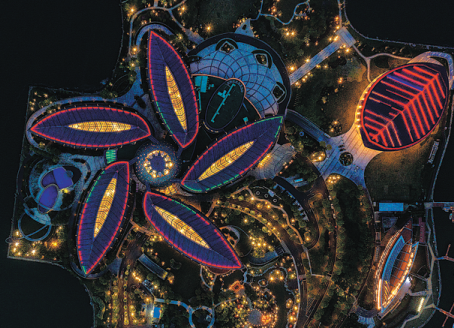Shanghai to develop five new suburbs over coming years


Lin'gang Special Area of the China (Shanghai) Pilot Free Trade Zone in Nanhui area is building facilities including this Crowne Plaza in the shape of a flower. CHEN MINGSONG/FOR CHINA DAILY
Each area to have its own unique industrial characteristics
Five new suburbs will be constructed in Shanghai during the 14th Five-Year Plan (2021-25), aimed at becoming "independent nodes" to create a fresh round of economic development.
From northwest to southeast, the five suburbs, referring to Jiading district, Qingpu district, Songjiang district, Fengxian district, and Nanhui region in Shanghai Pudong New Area, will circle the urban center of Shanghai.
The suburbs are the top priority in Shanghai's latest strategic plan for future development.
According to the city's 14th Five-Year Plan and Long-Term Vision for 2035, Shanghai will support the building of major industrial projects, high-quality public infrastructure, comprehensive transportation hubs, cultural and sports facilities in these areas.
The five suburbs will be developed as "independent and comprehensive nodes" among the city clusters in the Yangtze River Delta region. They will provide "strategic support for Shanghai's future development", Shanghai Mayor Gong Zheng said.
These node suburbs will help to optimize Shanghai's overall development layout and boost economic growth in the next five years, Gong said.
"Instead of seeing them as suburbs, we shall position the five new areas just like the other 40 cities in the delta, and build them into independent and comprehensive node cities that drive the growth of Shanghai and the Delta," said Tang Zhiping, vice-mayor of Shanghai.
According to municipal government of Shanghai, related supportive policies and measures will be unveiled this year to promote these suburbs and build them into independent nodes in the Yangtze River Delta by 2035.
These policies will cover many aspects, such as attracting talents, land planning, tax and fiscal incentives, as well as further business environment improvement, according to official documents.
According to a guideline on accelerating the construction of these suburbs for the next five years released in March, their combined population will grow to 3.6 million by 2025, with each suburb planned to have 1 million permanent residents by 2035.
Under the objective, attracting people to live and work in the areas has become one of the major goals. To encourage more young people to settle there, related rules for household registration will be reformed to meet the development need, said Li Jian, an urban and demography development expert from the Shanghai Academy of Social Science.
Creating distinct features
According to the guideline, each new suburb will establish an industrial park based on its own industrial characteristics.
Jiading district, a well-established area for Shanghai's automobile industry development, will focus on new-energy, self-driving vehicles and intelligent sensors.
Given its proximity to the Hongqiao international transportation hub, Qingpu district will pay more attention in modern logistics and exhibition industries. Meanwhile, as part of the demonstration zone for Yangtze River Delta integration, it will emphasize environmentally friendly development.
Songjiang district has long supported development of electronic information, integrated circuits and artificial intelligence along the G60 Corridor, a national expressway that connects Shanghai and Hangzhou. In the future, it will further develop its smart manufacturing industry.
In recent years, the beauty and healthcare industry has developed at a fast pace in Fengxian. The district plans to attract more heavyweight cosmetics companies to its Oriental Beauty Valley, which is set to be a world-class cosmetics and health industrial cluster in the region.
Nanhui in Pudong New Area, home to Lin'gang Special Area of China (Shanghai) Pilot Free Trade Zone, will develop the industries of integrated circuits, artificial intelligence and biomedicine.
With different features and advantages, each suburb will have its own industry development path. Industrial and urban integration will be achieved while providing residents with public facilities, a pleasant environment and convenient transportation, government officials said.
MOST POPULAR
- 1 China to give visa-free treatment to another 9 countries
- 2 China fully opens manufacturing sector to foreign investors in landmark opening up move
- 3 China's import expo attracts record-breaking participating countries, exhibitors
- 4 China's door opening even wider to foreign visitors, businesses
- 5 China revises rules to ease foreign strategic investment in listed firms
Editors' Picks
 Video:
Peru sees new port open
Video:
Peru sees new port open
 Infographic:
China's public holidays for 2025
Infographic:
China's public holidays for 2025
 Infographic:
Basic facts of APEC
Infographic:
Basic facts of APEC
 Infographic:
Wrapping up the 7th CIIE: Data recap
Infographic:
Wrapping up the 7th CIIE: Data recap



